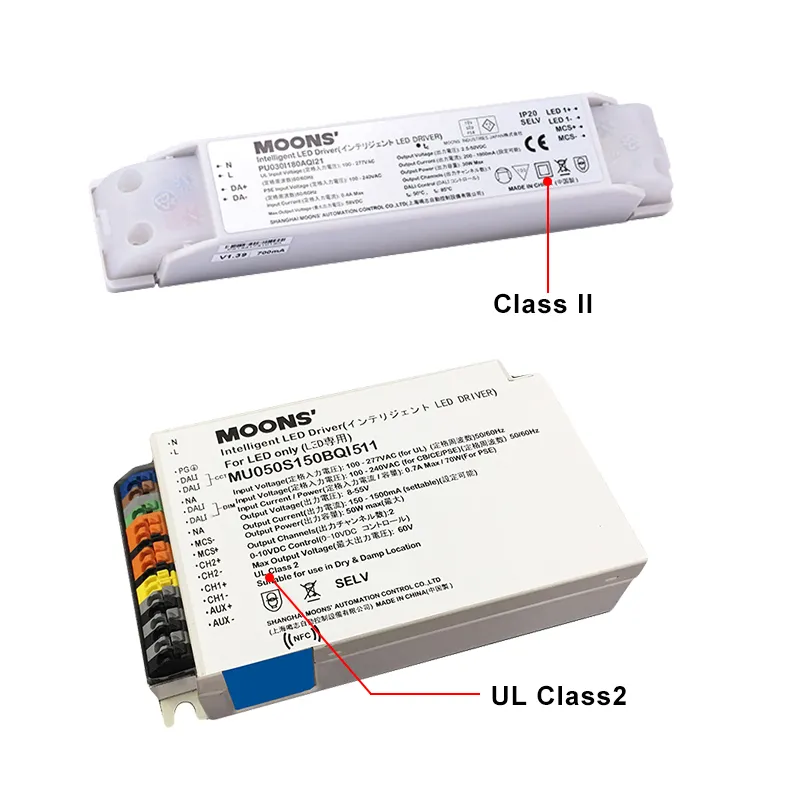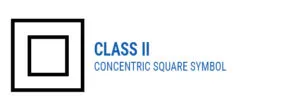What are the Difference between Class 1 and Class 2, Class I and Class II?
UL Class 1 vs UL Class 2
UL Class 2 drivers comply with UL1310, which means that their output is considered safe for contact and that no major safety protection is required at the LED or luminaire level. There are no risks of fire or electric shock. The drivers operate with less than 60 volts in dry applications, 30 volts in wet applications, less than 5 amps, and less than 100 watts. Nevertheless, these limitations limit the number of LEDs that can be driven by a Class 2 driver. UL Class 1 drivers have output ranges outside UL Class 2 designations. A LED Driver with a UL Class 1 rating has a high voltage output and safety protection is required. It is more efficient to use a Class 1 driver than a Class 2 driver because it can accommodate more LEDs. Additionally, there is often confusion regarding the difference between ac-dc power supplies rated Class 2 and Class II. There are significant differences between the two and it is important to understand them. The NEC (National Electric Code) identification of Class 2 refers to the output voltage and power capabilities of ac-dc supplies, whereas the IEC (International Electrotechnical Commission) designation of protection, Class II, refers to a power supply's internal construction and electrical insulation. Class II and Class2 Product
Class II and Class2 Product IEC Class II and Class I Insulation Protection
In order to protect users from electrical shock, IEC protection classes govern the design and insulation of power supplies. There are two layers of insulation (or one layer of reinforced insulation) between the user and the internal conductors of a Class II power supply. The first layer of insulation in supplies that have two layers of insulation is usually referred to as "Basic Insulation." The second layer of insulation is often an insulating case enclosing the product, such as the plastic case found on wall mounts and desktop power supplies. Wire insulation is an example of basic insulation. To reduce the possibility of electric shock, IEC Class I input models must incorporate a protective earth connection (ground). Label showing the IEC protection Class II symbol IEC protection Class II power supplies use a two-wire power cord rather than a three-wire power cord (Class I) with a Safety Earth connection. Typically, products designed with Class II insulation will be labeled as "Class II" or "double insulated" or will have the concentric square symbol on the safety label. Likewise, it looks similar to the Chinese character "回". In brief, the table below shows the difference between Class I, Class II, Class 1, and Class 2.
Label showing the IEC protection Class II symbol IEC protection Class II power supplies use a two-wire power cord rather than a three-wire power cord (Class I) with a Safety Earth connection. Typically, products designed with Class II insulation will be labeled as "Class II" or "double insulated" or will have the concentric square symbol on the safety label. Likewise, it looks similar to the Chinese character "回". In brief, the table below shows the difference between Class I, Class II, Class 1, and Class 2. | Classify | Class1 | Class2 | Class I | Class II |
| Authority | NEC | NEC | IEC | IEC |
| Insulation | Electrical limitation | Electrical limitation | basic insulation | Double Insulated |
| Symbol | UL | UL | / | 回 |
| Characteristic | Power≤1000 Volt-Amps | Voltage≤60(Dry) | three-wire power cord | two-wire power cord |
